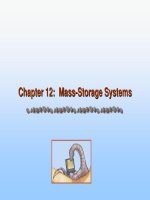Operating system concepts chapter 9 virtual memory
Bạn đang xem bản rút gọn của tài liệu. Xem và tải ngay bản đầy đủ của tài liệu tại đây (933.29 KB, 70 trang )
Chapter 9: Virtual Memory
Chapter 9: Virtual Memory
Background
Demand Paging
Copy-on-Write
Page Replacement
Allocation of Frames
Thrashing
Memory-Mapped Files
Allocating Kernel Memory
Other Considerations
Operating-System Examples
Operating System Concepts – 7th Edition, Feb 22, 2005
9.2
Silberschatz, Galvin and Gagne ©2005
Objectives
To describe the benefits of a virtual memory system
To explain the concepts of demand paging, page-replacement
algorithms, and allocation of page frames
To discuss the principle of the working-set model
Operating System Concepts – 7th Edition, Feb 22, 2005
9.3
Silberschatz, Galvin and Gagne ©2005
Background
Virtual memory – separation of user logical memory from physical
memory.
z
Only part of the program needs to be in memory for execution
z
Logical address space can therefore be much larger than
physical address space
z
Allows address spaces to be shared by several processes
z
Allows for more efficient process creation
Virtual memory can be implemented via:
z
Demand paging
z
Demand segmentation
Operating System Concepts – 7th Edition, Feb 22, 2005
9.4
Silberschatz, Galvin and Gagne ©2005
Virtual Memory That is Larger Than Physical Memory
⇒
Operating System Concepts – 7th Edition, Feb 22, 2005
9.5
Silberschatz, Galvin and Gagne ©2005
Virtual-address Space
Operating System Concepts – 7th Edition, Feb 22, 2005
9.6
Silberschatz, Galvin and Gagne ©2005
Shared Library Using Virtual Memory
Operating System Concepts – 7th Edition, Feb 22, 2005
9.7
Silberschatz, Galvin and Gagne ©2005
Demand Paging
Bring a page into memory only when it is needed
z
Less I/O needed
z
Less memory needed
z
Faster response
z
More users
Page is needed ⇒ reference to it
z
invalid reference ⇒ abort
z
not-in-memory ⇒ bring to memory
Lazy swapper – never swaps a page into memory unless page will
be needed
z
Swapper that deals with pages is a pager
Operating System Concepts – 7th Edition, Feb 22, 2005
9.8
Silberschatz, Galvin and Gagne ©2005
Transfer of a Paged Memory to Contiguous Disk Space
Operating System Concepts – 7th Edition, Feb 22, 2005
9.9
Silberschatz, Galvin and Gagne ©2005
Valid-Invalid Bit
With each page table entry a valid–invalid bit is associated
(v ⇒ in-memory, i ⇒ not-in-memory)
Initially valid–invalid bit is set to i on all entries
Example of a page table snapshot:
Frame #
valid-invalid bit
v
v
v
v
i
….
i
i
page table
During address translation, if valid–invalid bit in page table entry
is I ⇒ page fault
Operating System Concepts – 7th Edition, Feb 22, 2005
9.10
Silberschatz, Galvin and Gagne ©2005
Page Table When Some Pages Are Not in Main Memory
Operating System Concepts – 7th Edition, Feb 22, 2005
9.11
Silberschatz, Galvin and Gagne ©2005
Page Fault
If there is a reference to a page, first reference to that
page will trap to operating system:
page fault
1. Operating system looks at another table to decide:
z
z
Invalid reference ⇒ abort
Just not in memory
2. Get empty frame
3. Swap page into frame
4. Reset tables
5. Set validation bit = v
6. Restart the instruction that caused the page fault
Operating System Concepts – 7th Edition, Feb 22, 2005
9.12
Silberschatz, Galvin and Gagne ©2005
Page Fault (Cont.)
Restart instruction
z
block move
z
auto increment/decrement location
Operating System Concepts – 7th Edition, Feb 22, 2005
9.13
Silberschatz, Galvin and Gagne ©2005
Steps in Handling a Page Fault
Operating System Concepts – 7th Edition, Feb 22, 2005
9.14
Silberschatz, Galvin and Gagne ©2005
Performance of Demand Paging
Page Fault Rate 0 ≤ p ≤ 1.0
z
if p = 0 no page faults
z
if p = 1, every reference is a fault
Effective Access Time (EAT)
EAT = (1 – p) x memory access
+ p (page fault overhead
+ swap page out
+ swap page in
+ restart overhead
)
Operating System Concepts – 7th Edition, Feb 22, 2005
9.15
Silberschatz, Galvin and Gagne ©2005
Demand Paging Example
Memory access time = 200 nanoseconds
Average page-fault service time = 8 milliseconds
EAT = (1 – p) x 200 + p (8 milliseconds)
= (1 – p x 200 + p x 8,000,000
= 200 + p x 7,999,800
If one access out of 1,000 causes a page fault, then
EAT = 8.2 microseconds.
This is a slowdown by a factor of 40!!
Operating System Concepts – 7th Edition, Feb 22, 2005
9.16
Silberschatz, Galvin and Gagne ©2005
Process Creation
Virtual memory allows other benefits during process creation:
- Copy-on-Write
- Memory-Mapped Files (later)
Operating System Concepts – 7th Edition, Feb 22, 2005
9.17
Silberschatz, Galvin and Gagne ©2005
Copy-on-Write
Copy-on-Write (COW) allows both parent and child processes to
initially share the same pages in memory
If either process modifies a shared page, only then is the page
copied
COW allows more efficient process creation as only modified
pages are copied
Free pages are allocated from a pool of zeroed-out pages
Operating System Concepts – 7th Edition, Feb 22, 2005
9.18
Silberschatz, Galvin and Gagne ©2005
Before Process 1 Modifies Page C
Operating System Concepts – 7th Edition, Feb 22, 2005
9.19
Silberschatz, Galvin and Gagne ©2005
After Process 1 Modifies Page C
Operating System Concepts – 7th Edition, Feb 22, 2005
9.20
Silberschatz, Galvin and Gagne ©2005
What happens if there is no free frame?
Page replacement – find some page in memory, but not
really in use, swap it out
z
algorithm
z
performance – want an algorithm which will result in
minimum number of page faults
Same page may be brought into memory several times
Operating System Concepts – 7th Edition, Feb 22, 2005
9.21
Silberschatz, Galvin and Gagne ©2005
Page Replacement
Prevent over-allocation of memory by modifying page-fault service
routine to include page replacement
Use modify (dirty) bit to reduce overhead of page transfers – only
modified pages are written to disk
Page replacement completes separation between logical memory
and physical memory – large virtual memory can be provided on a
smaller physical memory
Operating System Concepts – 7th Edition, Feb 22, 2005
9.22
Silberschatz, Galvin and Gagne ©2005
Need For Page Replacement
Operating System Concepts – 7th Edition, Feb 22, 2005
9.23
Silberschatz, Galvin and Gagne ©2005
Basic Page Replacement
1.
Find the location of the desired page on disk
2.
Find a free frame:
- If there is a free frame, use it
- If there is no free frame, use a page replacement
algorithm to select a victim frame
3.
Bring the desired page into the (newly) free frame;
update the page and frame tables
4.
Restart the process
Operating System Concepts – 7th Edition, Feb 22, 2005
9.24
Silberschatz, Galvin and Gagne ©2005
Page Replacement
Operating System Concepts – 7th Edition, Feb 22, 2005
9.25
Silberschatz, Galvin and Gagne ©2005









